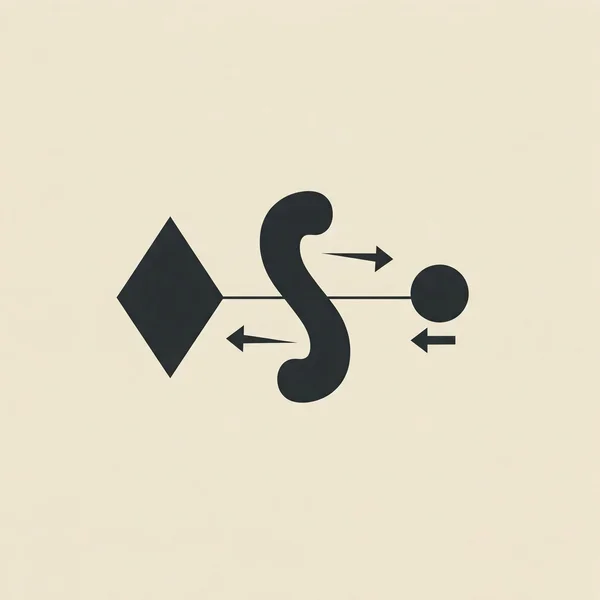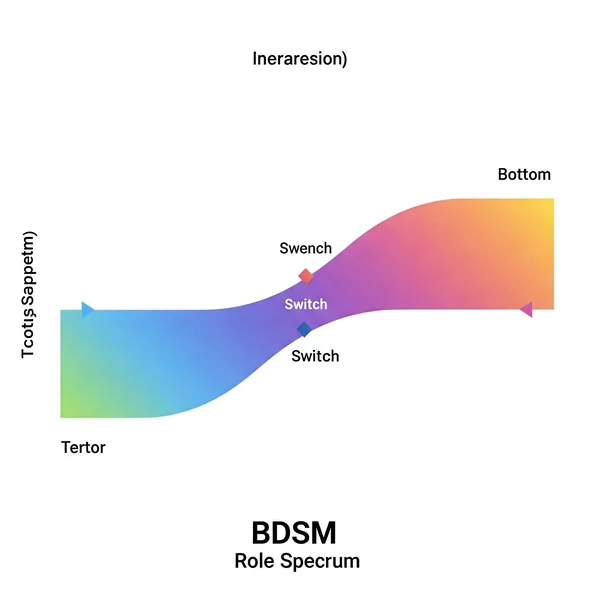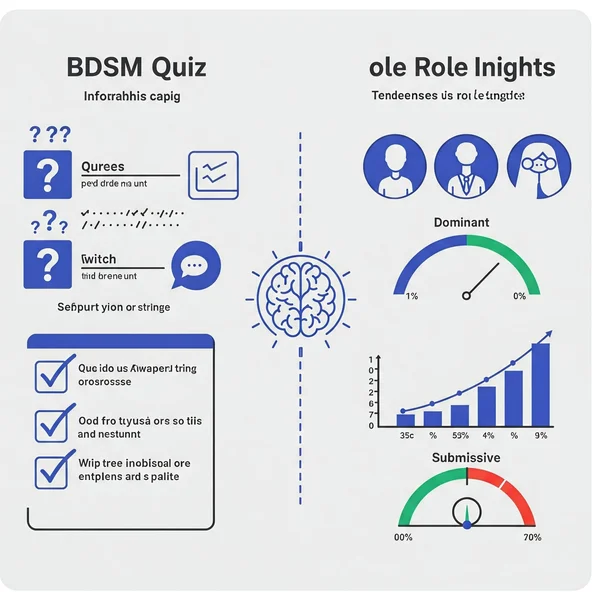Understanding BDSM Roles & Quiz Insights
Understanding BDSM Roles (Dominant, Submissive, Switch) via the BDSM Quiz
Dominant, Submissive, Switch – these terms frequently appear in discussions about BDSM. What defines a Dominant, Submissive, or Switch? If you're exploring BDSM or have taken an online BDSM quiz, you might be curious about what these BDSM roles mean and how they relate to your personal inclinations. This article aims to clarify these core role preferences, discuss their inherent flexibility, and explain how insights from tools like a dom sub test can aid in your journey of self-understanding. Let's delve into the fascinating world of power exchange dynamics. Curious about where your tendencies might lie? Discover insights with the BDSM Quiz.
Defining Core BDSM Roles: Dominant, Submissive, and Switch
While individual experiences within BDSM vary widely, these three roles represent common archetypes or tendencies in relationships and play that involve power exchange. So, what are the characteristics of these core BDSM roles?
The Dominant Role: Exploring Control and Authority
Often shortened to "Dom," an individual who identifies with or leans towards a Dominant role typically finds satisfaction in taking initiative, setting direction, guiding interactions, and exercising a degree of control or authority within a consensual dynamic. This isn't necessarily about being aggressive; it's more about embracing leadership, responsibility, and the enjoyment of orchestrating the power exchange in an agreed-upon manner.
The Submissive Role: Understanding Surrender and Service
A submissive (or "sub") generally finds fulfillment in willingly yielding control, following guidance, and experiencing a sense of surrender within a mutually agreed-upon framework. This can involve elements of service, obedience, or simply enjoying the release of certain responsibilities to a trusted Dominant partner. It's an active choice to entrust and explore this dynamic, not a passive state.
The Switch Role: Embracing Versatility in Power Exchange
A Switch is someone who enjoys and can comfortably embody aspects of both Dominant and submissive roles, often depending on the specific context, their partner, or their current mood. They appreciate the versatility of experiencing different facets of the power exchange dynamic, finding enjoyment in both leading and following, giving and receiving control.

It's a Spectrum: The Fluidity Within BDSM Role Preferences
It's crucial to understand that these BDSM roles are not rigid, unchanging boxes that people must fit into perfectly. Can my BDSM role change? The answer is a resounding yes, and here’s why.
Why BDSM Roles Aren't Always Black and White
Human desire, personality, and interactions are complex and multifaceted. Few people fit perfectly into one category all the time without any overlap or nuance. You might lean heavily towards one of the role preferences but occasionally enjoy aspects of another, or find your preferences shift based on the specific activity or your emotional state. These tendencies often exist on a spectrum.

Understanding Your Position on the Power Exchange Spectrum
Think of power exchange preferences as existing on a continuum rather than as distinct, separate points. You might find yourself strongly at one end, comfortably in the middle (as many Switches do), or perhaps leaning slightly one way while still appreciating elements usually associated with another role. There's immense fluidity in how individuals experience and express these dynamics.
How Roles Can Evolve Over Time or Based on Partners
Your preferred dynamics within a power exchange can certainly change throughout your life. Personal growth, new experiences, and self-reflection can all lead to shifts. Furthermore, the specific chemistry, trust, and agreements within a partnership can significantly influence how BDSM roles manifest and what feels most fulfilling.
How the BDSM Quiz Reflects Role Tendencies
So, how does an online questionnaire, often referred to as a BDSM quiz or dom sub test, fit into understanding these roles? And how seriously should I take quiz results?
Analyzing Responses Related to Control and Surrender
These online quizzes typically present a series of scenarios, statements, or questions related to preferences around giving or receiving control, taking initiative versus following directions, and the feelings associated with surrender or exercising authority. Your answers to these diverse questions create a pattern.
What Your BDSM Quiz Results Might Indicate About Your Leanings
Based on the pattern of your responses, the results of a BDSM quiz can offer an indication of your potential tendencies towards Dominant, submissive, or Switch role preferences. They often present this as percentages or scores, reflecting the balance of your answers across various themes related to power exchange.

Using the Dom Sub Test Insights for Reflection
The true value of a dom sub test lies in its ability to provide a starting point for personal reflection. The results are not a definitive diagnosis or an unchangeable label but rather personalized insights based on your self-reported answers at that moment. They can prompt you to think more deeply about your desires regarding power exchange and control. Considering a test to explore these aspects of yourself? You can reflect on your preferences at bdsmtest.online.
Beyond Dom/Sub/Switch: Other Dynamics in Power Exchange
While Dominant, Submissive, and Switch are common and foundational terms for BDSM roles, the landscape of power exchange and associated dynamics is richer and more varied.
Understanding Top vs Bottom Dynamics
The terms "Top" and "Bottom" often relate more specifically to the activity being performed within a scene rather than an overarching role identity. A "Top" is typically the person administering an action (like wielding an implement or directing a specific activity), while a "Bottom" is the person receiving it. It's possible for someone to be a Dominant Bottom (receiving sensation while maintaining overall authority) or a submissive Top (performing an action under direction), highlighting that role preferences and activity roles aren't always synonymous.
Exploring Service-Oriented Roles
Some individuals find that their primary expression and enjoyment within a power exchange dynamic centers heavily on acts of service. This can lead to identifications such as "Service submissive," who finds deep fulfillment in serving their partner, or even "Service Dominant," who might derive satisfaction from providing specific forms of guidance, care, or structured support.
Brief Mention of Other Specific Role Identifiers
The BDSM community utilizes many other descriptive terms to articulate specific role preferences or nuanced dynamics. Examples include Caregiver/little (CG/l), which involves nurturing and childlike play; Master/slave (M/s), implying a deep and often long-term power imbalance; or Owner/pet, which involves specific themes of ownership and animalistic play. These often imply particular expectations and intimacies beyond the basic Dom/Sub/Switch framework.
Does a Label Matter? Roles as Tools for Self-Understanding
With such a variety of terms and concepts, you might reasonably wonder how important these labels truly are for your personal journey of self-understanding.
The Value of Labels for Identity and Community
For some people, identifying with a specific role label like Dominant, submissive, or Switch provides a valuable sense of identity and validation. These labels can offer a useful shorthand for expressing complex preferences and can help individuals find and connect with a wider community of like-minded people.
When Labels Feel Limiting: Prioritizing Personal Experience
However, for others, strict adherence to labels can feel restrictive or inaccurate. If you find that no single term perfectly captures your diverse experiences, or if your feelings and preferences are fluid and change over time or with different partners, that is perfectly valid. Prioritizing your authentic personal experience over fitting neatly into a predefined box is key to genuine self-understanding.

Focusing on Communication Over Strict Role Adherence
Ultimately, open, honest, and ongoing communication with partners about desires, boundaries, expectations, and how you wish to engage in power exchange within a specific dynamic is far more important than rigidly adhering to any particular role label. Understanding your general tendencies and role preferences can certainly aid this communication, making it more effective.
Discover Your Leanings: Taking the Dom Sub Test
Exploring BDSM roles is a deeply personal journey into understanding power dynamics, desire, and your own unique preferences. Whether you find yourself leaning towards being Dominant, submissive, a Switch, or something else entirely, the key is self-awareness, consent, and respectful interaction.
Key Insights into BDSM Roles and Fluidity
We've defined the core BDSM roles, emphasized their inherent fluidity and existence on a spectrum, and discussed how tools like an online BDSM quiz can offer valuable insights into your role preferences as part of your ongoing self-understanding.
Curious About Your Tendencies? Try the BDSM Quiz Now
If you're interested in a structured, private way to reflect on your leanings regarding control, surrender, and versatility in power exchange, taking an online dom sub test can be an illuminating and helpful step on your path.
What Are Your Thoughts on BDSM Roles?
How do you view BDSM roles in your own exploration? Do you find labels helpful, or do you prefer a more fluid approach? We encourage you to reflect on these questions as you continue your journey.
Common Questions About BDSM Roles Answered
Let's address some common questions that arise when discussing BDSM roles:
Are Dominant/Submissive/Switch the only BDSM roles?
No, they are perhaps the most widely recognized foundational BDSM roles, but they are by no means exhaustive. As mentioned earlier, terms like Top/Bottom, Master/slave, Caregiver/little, Owner/pet, and many others exist within the broader BDSM community, describing different facets or more specific types of dynamics and role preferences.
What if I don't strongly identify with any role after the test?
What if I don't identify with any role? That's perfectly okay and quite common! The BDSM quiz is a tool designed to provide insights and spark reflection, not to rigidly categorize everyone. You might have very balanced tendencies, unique preferences not easily captured by these broad labels, or you may simply not find role labels personally meaningful or necessary for your self-understanding. Your authentic experience is what matters most.
Can my BDSM role change depending on my partner?
Can my BDSM role change? Yes, very much so. The specific dynamic, level of trust, emotional connection, and even the particular kinks explored with a partner can significantly influence which aspects of the power exchange spectrum and which BDSM roles feel most natural or appealing to you at that time. Fluidity in role preferences is common and natural.
How seriously should I take the role percentages in the quiz results?
Think of the percentages or scores from a dom sub test as indicators of your reported tendencies based on your answers at that particular moment, not as fixed, unchangeable personality traits. If the results show, for example, 70% Dominant tendencies and 30% submissive tendencies, it suggests a stronger leaning towards Dominant patterns in your responses at that time, while also acknowledging the presence of the other. Use these results as a springboard for further reflection and self-understanding, not as rigid definitions. Ready to see what insights a BDSM quiz might offer you? You can take the test at bdsmtest.online.